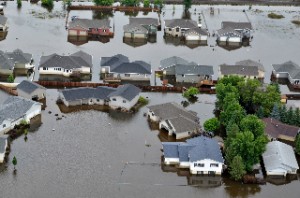

There is a new study out that examines the U.S. flood insurance program. And it says that according to its calculations, there are some regions in the country where National Flood Insurance Program (NFIP) premiums are too high.
The report is from the Wharton Risk Management and Decision Processes Center at the Wharton School of the University of Pennsylvania. It says these high premiums in some areas present opportunities for private insurers to provide coverage and complement the NFIP.
In the U.S., residential flood insurance is provided mainly by the NFIP, which was established in 1968. It has been covering more than five million households ($1.25 trillion of property) across the country and has been renewed more than a dozen times over the past three years, including after first being allowed to lapse.

But the program also faces important challenges: For example, it is now $17.8 billion in debt due to historical levels of flood claims following the 2005 and 2008 hurricane seasons. Also, many residents in flood-prone areas are not insured and many maps used to determine flood zones are outdated.
There is a growing consensus that the NFIP needs reforms. The Federal Emergency Management Agency (FEMA), which is responsible for the NFIP, has recently proposed several reform options, including privatization of flood insurance.
Many believe that private flood insurance will always be more costly than what the NFIP currently charges. But the Wharton study says that may not be the case.
The Wharton study, with probabilistic catastrophe flood modeling conducted by CoreLogic, analyzed the likelihood of future catastrophic flooding — and the potential cost of providing private flood insurance — in a pilot study focusing on two flood-prone counties in Texas.
The analysis calculated the “actuarially fair” flood insurance premium, based on the probabilistic risk models, for more than 300,000 residences in Galveston and Travis Counties. The Wharton study then compared these rates to the rates currently charged by the NFIP.
Based on those estimates, the report shows in the regions analyzed that there are certain areas where NFIP premiums, are, on average, too high (and other areas where premiums on average are too low).
“This presents opportunities for private insurers to provide coverage in some of those areas, to complement the NFIP,” said Erwann Michel-Kerjan, Risk Center managing director and study co-author.
“There are several practical barriers that would need to be addressed for private insurers to sell such coverage, but if done, this could significantly increase the number of residents with proper coverage, thus reducing the need for government disaster relief.”
The full report can be found at: http://opim.wharton.upenn.edu/risk/library/WhartonRiskCenter_TexasFloodInsurancePricingStudy.pdf